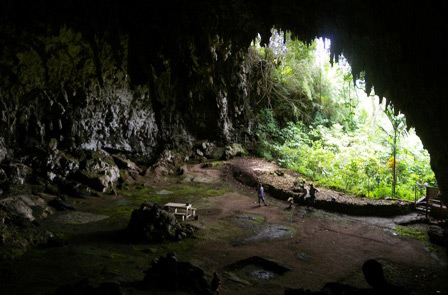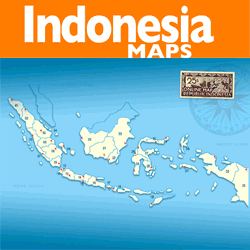Liang Bua Cave

Liang Bua is a prehistoric relic in Indonesia. The cave is one of the many karst caves on Flores Island, East Nusa Tenggara in Indonesia. Liang Bua Cave is a place of discovery of human-like creatures (hominins) has named Homo floresiensis at Liang Bua on 2001 in Manggarai language means "cave or hole cool".
In Liang Bua Cave there are stalactites and stalagmites in the cave. In olden days, the cave used to be a dwelling place to the local people as well as the school for the neighboring villages. The cave is located at Rampasasa Hamlet, Liangbua Village, Ruteng District, Manggarai Regency, about 12 km northwest of Ruteng. It is easy to get there by motorbike and truck.
Liang Bua cave site is one of the world's most important archaeological sites. Excavations in Liang Bua cave near Ruteng have unearthed fossilized bones of a human species the adults of which reached a height of only 105 cm on average. The excavations took place in 2003 and subsequent years, the remains of at least 7 individuals have been discovered. The scientific name of the species is homo floresiensis, but the nickname “Flores hobbit” has become more popular.
The fossils were found under layers of about 6 m volcanic ash and mud, and were associated with stone tools and fossils of animals, such as komodo lizards and small-sized stegodon (kind of elephants). They were dated between 30,000 and 18,000 years ago.
The debate is still ongoing where to place these mini-humans on the evolutionary tree, but the prevalent explanation is that they are homo sapiens whose size had gradually diminished. This is known as dwarfism and not uncommon among animal species living on an island.
The large cave is half open facing a river valley, and it is easy to see that it was an attractive dwelling place to prehistoric man. If you are willing to spend another Rp 50,000 apart from the voluntary donation in the guest book, a ‘real’ hobbit man will present himself. Despite its famous archaeological findings, no replica or information about these findings is located in Liang Bua. Visitors can only see the massive cave with stalagmite stones, imaginating that ancient elephants, komodo and short humans (Homo floresiensis) once lived here thousands of years ago. Near Liang Bua, there are other caves such as Gua Galang (with bathing stones) and Gua Tanah. You can walk to these caves.
To reach Liang Bua Cave, you can accompany by guide, but can also find the location on your own. From Jalan Komodo (the road to Labuan Bajo) follow the road north direction Reo for 2,5 km. There take the sealed road on your left, through Lalong village. After 14 km on this road you reach the entrance porch; the cave is 1 km beyond the porch.

Planning Your Wonderful Trip to Labuan Bajo And Komodo Island
Indonesia has thousands hundreds of islands. That is a very amazing fact because Indonesia is indeed an archipelagic country. Several islands in Indonesia are uninhabited but are still frequently visited by many tourists. This is because all the islands in Indonesia have their charm, have beautiful beaches, and are unique in their own right. Of all the islands owned, the only island inhabited by ancient animals is the Komodo dragon which can be visited by tourists. If you are looking for an all-in-one adventure experience, see Komodo dragons in their…
The Uniqueness of Koja Doi Tourism Village in East Nusa Tenggara
Koja Doi Village is located in East Alok sub-district, Sikka Regency, East Nusa Tenggara (NTT). Visitors can access this village by boat with a travel time of about 40 minutes from Nangahale Harbor. Koja Doi is one of the tourist villages that won the Indonesia Sustainable Tourism Award (ISTA) from the Ministry of Tourism and Creative Economy. This village offers marine tourism, nature tourism, and cultural tourism. Koja Doi Village has several spot to visit, such as the site of the 1992 tsunami, a stone bridge, ancient rock hills, and…
Enjoying the Enchantment of Marosi Beach in West Sumba
West Sumba has a number of beaches that are destinations and attractions for its tourism sector. One of them is Marosi Beach. This beach is located in Lamboya District. You don’t need long from Waikabubak to the location. Enough to travel overland for approximately one hour. In fact, you are also not charged a levy when entering this beach area. Marosi Beach is a beach that is completely empty of visitors. This is a recommended place for those of you who want to get rid of boredom from tired activities.…
Exploring Aili Beach in Central Sumba
Aili Beach in Central Sumba Regency, East Nusa Tenggara Province No one can deny the values of natural attractions like beaches, no? When it is about beautiful beaches, East Nusa Tenggara Province has many of them including the one called Aili Beach of Central Sumba Regency. To be exact, the location is in Konda Maloba Village and it resides in South Katikutana Sub-District. Like other beaches of NTT Province, this one is recognized for its pristine nuance and beautiful white sand. The good thing is that it resides in the…






